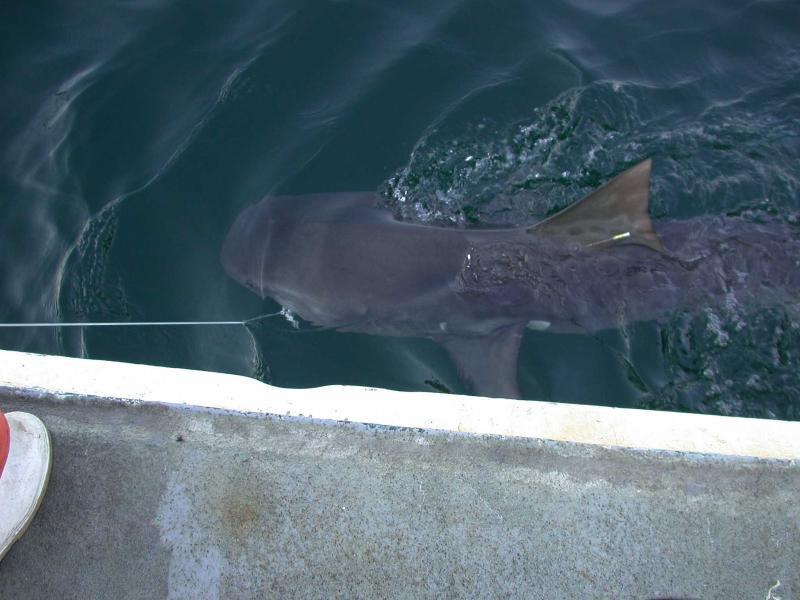
Climate change is shifting tiger shark populations northward
by NOAA Fisheries 30 Jan 2022 16:15 UTC

Tiger shark caught by longline on a NOAA Fisheries' Apex Predators Program research survey. This shark was tagged with a conventional tag (seen in the photo below the dorsal fin) from the NOAA Fisheries' Cooperative Shark Tagging Program before release © NOAA Fisheries
A new study has found that tiger sharks' seasonal distribution has expanded in the northwest Atlantic Ocean over the last several decades.
This large-scale northward expansion was driven by climate change, specifically the overall warming of the U.S. Northeast Continental Shelf Large Marine Ecosystem, researchers found. The research was published in the journal Global Change Biology.
"Our tagging and tournament sampling data show that tiger sharks have always spent time in northern latitudes at least going back to the 1960s and 1970s," said Cami McCandless, study co-author and lead for the NOAA Fisheries' Apex Predators Program. "But now they are not only arriving earlier but spending more time in northern latitudes due to ocean warming."
Tiger sharks are a highly migratory species with a distribution that stretches from Cape Cod, Massachusetts to Florida and the Gulf of Mexico. They prefer warm waters (roughly 72 degrees Fahrenheit or warmer). This paper presents empirical evidence of a climate-driven shift in distribution and migration timing for an apex predator—a species at the top of the marine food web.
Tiger sharks are not targeted commercially in U.S. waters, but they can be caught as bycatch. Increasing water temperatures have shifted tiger shark movements beyond management areas that are closed to longline activities, increasing their vulnerability to these fisheries.
To investigate changes in tiger shark seasonal distribution, the authors used combined analyses of:
- Satellite telemetry data from the University of Miami
- Remotely sensed environmental data from NOAA CoastWatch
- Habitat modeling
- Capture data (both tagging and recapture events) from the NOAA Fisheries' Cooperative Shark Tagging Program
The tagging information was based on data from 47 tracked tiger sharks from 2010-2019, which were detected at 5,776 locations throughout the Atlantic. They compared this data to 8,764 tiger shark capture locations from the tagging program spanning nearly 40 years (1980-2018).
Rapid northward expansion
Tiger sharks are arriving in northeast shelf waters earlier and expanding their movements north during these migrations when years and seasons experienced high sea-surface temperature anomalies. Satellite telemetry data suggest that, on average, for every 1 degree increase in sea-surface temperature anomalies, tiger sharks have arrived in northern waters 14 days earlier. They also extended their movements farther north by nearly 4 degrees of latitude.
Data from the Cooperative Shark Tagging Program support these findings. They indicate that the northern edge of high-catch density areas shifted north during the warm seasons by more than 400 kilometers since the 1980s. This paralleled a shift in their preferred temperature range (26-28 degrees Celsius, figure below). The capture data also showed progressively earlier tiger shark catches in northern waters across years.
Other biological, demographic, and environmental factors may also contribute to these habitat use patterns. However, the authors concluded that climate change is a major force.
Climate change impacts on the northeast ecosystem
The global ocean has warmed steadily since the 1970s. Some of the highest rates of change are in productive areas such as the U.S. Northeast Continental Shelf Large Marine Ecosystem. Research has documented some climate-driven shifts in distributions for marine species, but these are highly variable among taxonomic groups and ocean regions. Key research priorities are determining the rate and direction of range shifts and understanding the mechanisms driving them.
McCandless said, "This research highlights the importance of continuing long-term data collection programs, like our Cooperative Shark Tagging Program, to help monitor species distributions and migrations as their environment continues to change."
Distribution changes affect predator-prey relationships, when and where human-wildlife conflicts occur, and other factors. Research like this, which identifies the effects of climate change on a species, allows resource managers to incorporate distribution changes into management decisions.